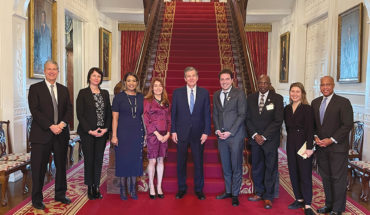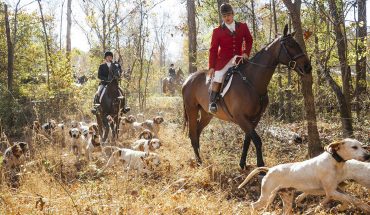by J. Michael Welton
photographs by Travis Dove
When 22 rare Porsches roll into the North Carolina Museum of Art on Oct. 11 for Porsche by Design: Seducing Speed, it will mark not only the first time the museum has mounted a design exhibit, it will also be the first time that iconic cars owned by Janis Joplin, Steve McQueen and Ralph Lauren will stand, side-by-side, in the same place at once. It will be the only time a one-of-a-kind Panamerica concept car has ever left its home in the Porsche museum in Stuttgart, Germany. And it may be the first time ever that car fanatics and art lovers can agree on the best way to spend a Saturday afternoon.
That’s what happens when a museum director willing to think outside the frame and a world-class car collector based in Durham join forces: Some of the finest, fastest and most aesthetically pleasing automobiles ever to grace this world’s roads and tracks come together. Inspiration for the exhibition came about when NCMA director Larry Wheeler began to familiarize himself with the extremely rare collection of Porsches owned by retired Glaxo CEO Bob Ingram and his family.
“I’ve known the Ingrams for 18 years,” Wheeler says. “Without their enthusiasm, we never would have done the show. In addition to their collection of cars, they have connections all over the world, and they used them on our behalf to contact other friends and collectors.”
The show, several years in the making, will trace the work of three generations of the German racecar manufacturer. Two of the vehicles in the exhibition – a 1949 356 Gmünd Coupe and a 1961 356B Carrera GTL Abarth Coupe – are part of the Ingram collection.
Plans for the exhibit began to gather steam when Ken Gross, a former executive director of the Peterson Automotive Museum in Los Angeles and a noted automotive journalist, came on board as co-curator in 2011. He joined Barbara Wiedemann of the NCMA in planning the show.
“Automobiles can be considered a kind of kinetic art – an industrial design that’s styled and purpose-built,” Gross says. He cites as precedent the Museum of Modern Art’s 1951 exhibition, 8 Automobiles, described by its curator Arthur Drexler as “hollow, rolling sculpture.”
NCMA’s exhibit starts with a 1938 Type 64 Berlin-Rom Racer. That teardrop-shaped, seminal masterpiece seems to have sprung, fully formed, from the fertile imagination of Ferdinand Porsche. It was to be his entry for the 1939 Berlin-to-Rome road race.
“You can see what started in 1938 and how it evolves today and stays true to itself,” says Gross.
One iteration of that evolution, on display just inside the main entrance of NCMA’s West Building, is Janis Joplin’s perky, psychedelic 1965 356 C Cabriolet. “She got it when she started making money,” Gross says. “She bought it in 1968 and paid $3,500 for it.”
The balance of this lithe and muscular collection lies in the East Building, in chronological order. Among them is Steve McQueen’s 1958 356 A Super Speedster. “It’s a Super 88,” Gross says. “Naturally, McQueen would buy the more powerful of the two offered. He raced it in California – he was a competitive guy.”
Most Porsche owners are cut from the same cloth, including local members of the Hurricane Region of the Porsche Club of America. Many of its members race on regional tracks, while others serve as instructors for driver education. At the heart of the club lies a strong sense of camaraderie.
“The motto is ‘It’s not just the cars – it’s the people,’” says Karen Adams of Raleigh, a member since 1992.
They take that motto seriously. Members are all over the NCMA exhibition – serving as docents for tours, displaying cars at local events to promote the show, and gathering at the museum for public meet-ups.
They’re a diverse group of aficionados tied together by a common love for a car whose legacy is speed and style. To prove it, seven of its members agreed to share their Porsche stories:
Built for speed
Guangming Cui, 39, was born in Shenyang, 500 miles north of Beijing. In 1996, he arrived at the University of Louisville to study ophthalmology and visual sciences. Trained as a research scientist, he earned his PhD, and chose a career as a computer engineer in Raleigh.
Then he stepped up to a 2011 Porsche Cayman R – the racing version of that mid-engine Porsche, with a 2.4-liter, 330-horsepower, flat-six motor.
“I was looking online, and this one showed up with the options I needed,” he says.
He knew what he wanted: A car built for speed, not comfort. This model is lighter than the standard Cayman: no radio, air conditioning, or navigation system. Doors are made of aluminum, and all sound-deadening material is removed. Plain red nylon straps serve as door handles inside.
“There’s no compromise,” he says. “It’s purposely designed to go fast.”
He’s tested it at the Virginia International Raceway, pushing it up to 130 mph. “It was scary,” he says. “I was in fourth gear and could have gone faster in fifth – but I didn’t.”
He’s got no plans to return to China anytime soon, but if he does, he’ll take his Porsche with him. “It puts a smile on me every time I drive it,” he says.
Matisse at the track
You’d think by now that Karen Adams, a business consultant in her 50s, might have lost count of how many Porsches she and her husband Doug have owned. She’ll never forget their first one, though.
“In 1992, a neighbor of ours pointed us to a couple who had a 1981 911 SC,” she says. “We looked at it, hit it off with them, and two weeks later we were at the racetrack.”
She’s never looked back. For decades, Adams has been running Porsches at nearly every track on the East Coast. The couple have transformed a 1989 930 Turbo from street car to race car. Her own street car is a 1990 944 S2. They’ve also bought a 1995 911 – a 993 model, one of the last that’s air-cooled.
Recently, they took what she calls the final step: “We bought identical cars from a German race team.”
Still, it’s the source of that first car, Dave and Susana Weber, whom she remembers best – and for good reason. When it came time to have her helmet painted, she turned to Susana, an artist by profession.
“She asked what I wanted the design to look like,” she says. “I said: a Matisse piece, from his work with cut paper.”
And that’s what she wears while she’s tearing up the track at 150 mph.
A spiritual extension
When Benny Suggs, 66, placed second in flight school in the early 1970s, the Navy gave him his choice of aircraft.
He chose jets, then trained as an attack pilot. For three decades, he flew almost everything in the naval inventory: the F4, F14, A4, A6, and A7, even copiloting S3 helicopters. His was the first squadron in the last air wing to come home from Vietnam, and he saw duty in the Eastern Mediterranean, the Persian Gulf, and Haiti. He closed out his service as a two-star rear admiral and deputy commander of U.S. Special Operations in Tampa.
“Performance has been a big part of my career,” he says. “And Porsche fits that niche.”
His first was a brand-new 1983 911 SC Cabriolet convertible. Selling it is something he still regrets: “I was broken-hearted,” he says. “I don’t make a lot of mistakes, but that was one.”
Since then there have been two more 911s, a BMW, and a Mercedes. Now he drives a 2012 Carrera S 911 Coupe.
He calls it a spiritual extension of his body. “Like all the high performance jets I’ve flown,” he says. “You don’t sit in it – you get in and strap it on your back and take it with you.”
Gender issues
When computer program manager Lila Kimsley started looking at sports cars, she thought Porsches were too masculine. So she bought a red Mazda Miata. And then another.
But a friend had a Porsche. And Kimsley decided that she, too, wanted that kind of power and control. She gave in to the magnetic pull of a midnight blue 2008 Boxster with 13,000 miles.
“It’s got 20,000 on it now,” she says. “That’s all I’ve done with it, and that means I haven’t had enough fun. She’s sitting in the garage and she needs to get out and play.”
She?
“Yes,” Kimsley says. “It’s a she – all my cars are shes. Wait – actually, the Acura MDX might be a he.”
Her Boxster has a spirit of her own, she says. “It’s solid and it’s fast and it’s extremely well engineered,” she says. “The car can do more than I do. If I’m going into a curve at a pretty good clip, it can handle it.”
Trust it is what club instructors told her in driver education. And so she does – especially when it’s just the two of them tooling through Bailey Farm in suburban Raleigh.
“It’s fun,” she says. “And it’s freedom.”
That definitely makes it a she.
Love me two times
Gobeail McKinley is a two-time Porsche owner. The 30-year-old environmental protection specialist with the EPA is on her second Boxster in five years. That’s because two years ago, her first one – a fire-engine-red, mid-engine affair – spun her around a full 360 degrees.
“An animal came out in front of me, and I tried to turn, but it went out of control,” she says. “I hit the median and the airbag deployed. The whole back of the car – the wheel and tire – were gone.”
She walked away from the totaled car, then went out and bought another. This one’s a softer burgundy hue. “I like them,” she says. “It’s kind of like a roller coaster ride on curves and turns.”
She has torqued the new one up to 90 mph, and believes she once hit 115 in the old one – but she’s uncertain about that. “When you’re going that fast, you can’t look at the speedometer,” she says.
A look in the rear-view mirror
A lot of former Porsche owners cast wistful glances back to the days when the streamlined little 356 model seemed almost as commonplace as its sibling, the Volkswagen bug.
Gary Ross, a 64-year-old business analyst, might be one of them. “I bought my first Porsche in 1976 when I was 26 years old,” he says. “I always wanted one, and I found one I could afford – a 356 Super C in Rocky Mount, for $500.”
When he brought it back to Raleigh, it enjoyed dubious status as one of the few 356es in town. “They weren’t held in high esteem,” he says.” It was just an old Porsche, and the new ones were so much nicer.” Two years later, he felt guilty for selling it for $750. “I thought I’d robbed the guy,” he says.
In 2006, he and his wife purchased a 964 turbo, the last two-wheel drive, air-cooled 911 made. Only 674 were produced, and theirs was No. 521. In six short years, it went from unloved Porsche to rare, in-demand commodity.
In 2012, he sold that car for 50 percent more than he paid. Today it might bring $20,000.
Compared to some, though, that price seems a trifle: Today, a 356 Super C – like the one he owned in 1976 – could fetch $100,000.
Who knew?
Bat out of hell
James DeCoursey’s Porsche 911 Turbo is a family affair, and a car that the 46-year-old estimating manager and his wife have owned twice.
“We bought it from my father-in-law in the fall of 2004. He’d bought it in August 1993, with 16,000 miles,” DeCoursey says. “We bought it at 19,000 miles.”
Then the couple made the mistake of asking his wife’s mother if she thought her husband missed it. “He said he did – so we sold it back to him in 2007,” he says.
By 2010, they were back in the driver’s seat. To date, the little Porsche they call “The Orange Car” has ticked off just 29,000 miles. DeCoursey drives it just once a week to work and on weekends to Porsche club get-togethers.
“We own it, and we enjoy it, but we’re not technical like a lot of members are,” he says. “I know it’s a 911, but we don’t immerse ourselves in all the details.”
Its appeal lies in how it handles itself. “It’s fantastic – it’s very responsive,” he says. “As my wife says, it’s catlike.” And then there’s that signature Porsche turbo lag: “It’s not so fast up to 30 mph, but past 30, it’s like a bat out of hell. It’s a very fast car.”











